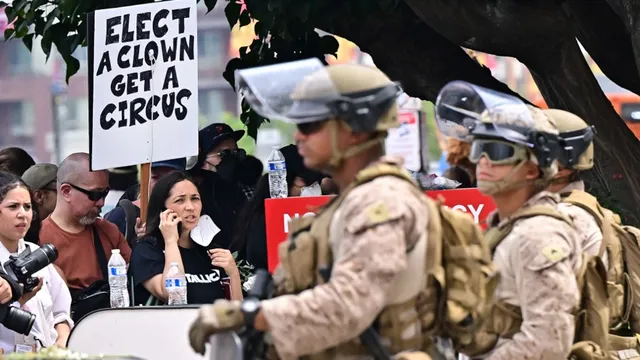
Protests planned against Trump’s military parade and birthday celebration
2025-06-16 10:30- Protests are set to occur across the U.S. on June 14, 2025, coinciding with a military parade in Washington D.C.
- Organizer groups are calling for nonviolent demonstrations against what they see as Trump's extravagant celebration funded by taxpayers.
- The event highlights significant public discontent with the Trump's administration's priorities while many social services face cuts.
Express your sentiment!
Insights
On June 14, 2025, nationwide protests are organized to coincide with a military parade in Washington, D.C., marking the Army's 250th anniversary, President Donald Trump’s 79th birthday, and Flag Day. The protests, branded the 'No Kings' protests, have materialized in response to the administration's perceived misuse of taxpayer funds for a parade deemed extravagant by critics. Organizers argue that as the federal government grapples with budget constraints in social services, the military parade represents a prioritization of spectacle over essential services. The flagship protest is scheduled in Philadelphia, where attendees will gather at Love Park before marching to the Art Museum steps. With predictions of almost 2,000 protests taking place nationwide, the groups behind this movement anticipate participation from millions. It is crucial to note that the protests are intended to be nonviolent, with a focus on peaceful demonstration against Trump's administration and its policies towards civil rights and social services. The protests highlight the growing discontent among some citizens regarding the actions of their government, particularly drawing attention to issues like deportations and slashes to social programs. Activists from various backgrounds are expected to participate, signaling a collective frustration against a system viewed as catering to wealthy allies while neglecting vulnerable populations. This event is also viewed as an opportunity for the public to voice their opposition to what they perceive as a royal-like governance style embodied by Trump. Interestingly, significant numbers of congressional Republicans have expressed reluctance to fully support or attend the military parade, reflecting a divide within the party regarding the display of military might. Many Republicans show discomfort with the parade's estimated cost of $45 million, fearing it reflects the extravagance that could be interpreted as a sign of weakness. Notably, this internal conflict suggests that even among Trump's party, there is a growing concern about public perception and the appropriateness of such flamboyant displays, especially when juxtaposed against pressing social issues. The upcoming protests clearly represent a pivotal moment in mobilization against the Trump administration. Activists are planning not only to challenge the military parade on the day itself but are also positioned to critique the broader implications of Trump's governance style. The 'No Kings' movement calls for a rejection of the idea of 'kings' within a democratic system, stressing the importance of maintaining civil rights and prioritizing the needs of the people. The day is framed as a response to what activists describe as an affront to democratic values and a step towards pushing for accountability and change within the political landscape.
Contexts
The military parade proposed by former President Donald Trump was intended to showcase American military strength and patriotism. The initiative stemmed from Trump's admiration for military displays seen in other countries, such as France's Bastille Day celebration. The idea gained traction in early 2017, but a detailed plan was not fully developed until 2018, when funding and logistical considerations became a point of contention. The parade was envisioned to feature military vehicles, aircraft, and various service members, intended to be a visually impressive event that would resonate with Trump's base and the American public at large. However, the effort faced criticism regarding its appropriateness and cost amid other pressing national priorities. The estimated cost of the parade raised eyebrows, leading to significant debate among lawmakers and military officials. Initial projections indicated that the event could cost anywhere from $10 million to potentially $30 million. These figures included expenses for security, transportation, and logistical support, as well as costs associated with the maintenance and operation of military vehicles and aircraft. Critics argued that these funds could be better allocated to veteran services or military readiness rather than a spectacle meant to elevate Trump's image. This pushback culminated in the eventual delay and reevaluation of the parade's feasibility. In August 2018, the Pentagon announced that the parade would be postponed, citing that more time was needed for planning and budgetary adjustments. The decision also reflected the increasing concerns over the event's appropriateness considering the context of a divided nation and the prominence of military engagements in contemporary politics. Over the subsequent months, there was further discussion about the implications of such a display of military might within the United States, questioning the symbolic nature of a military parade in a country where civilian control of the military is constitutionally mandated. Ultimately, the military parade was never realized during Trump's presidency, and discussions about it transitioned into the broader narrative of the relationship between politics and military in American society. Analysis of the proposal reveals deep societal rifts concerning nationalism versus democracy and civilian outlook on military parades as representations of national pride or authoritarianism. The costs associated with the parade reflect broader fiscal concerns influencing not only military initiatives but also military culture and public sentiment, ultimately showcasing the complex relationship between government expenditure and the public's perception of patriotism.